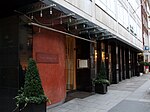Bruton Street

Bruton Street is a street in London's Mayfair district. It runs from Berkeley Square in the south-west to New Bond Street in the north-east, where it continues as Conduit Street. Notable residents have included Field Marshal John Campbell, 2nd Duke of Argyll, and Richard Brinsley Sheridan.On 21 April 1926, Queen Elizabeth II was born at No. 17, the London home of her maternal grandfather, the Earl of Strathmore and Kinghorne. The house was commonly thought to have been damaged in the Blitz and demolished in the aftermath, but archival documents at the British Library prove that the house had been demolished by property developers between 1937 and 1939, before the start of the war.The fashion designer Norman Hartnell lived and worked at No. 26 from 1935 until his death in 1979.
Excerpt from the Wikipedia article Bruton Street (License: CC BY-SA 3.0, Authors, Images).Bruton Street
Berkeley Square, City of Westminster Mayfair
Geographical coordinates (GPS) Address Nearby Places Show on map
Geographical coordinates (GPS)
| Latitude | Longitude |
|---|---|
| N 51.51032 ° | E -0.145 ° |
Address
Berkeley Square House
Berkeley Square
W1J 6BE City of Westminster, Mayfair
England, United Kingdom
Open on Google Maps







